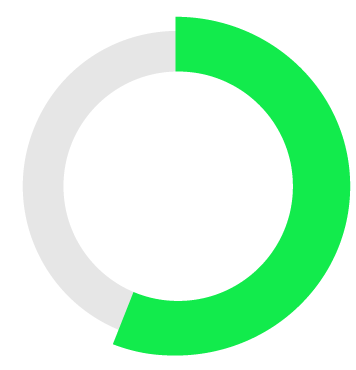
→
→
Market of counterfeit
children's toys
in Russia
Read
Read



→
→
Market of counterfeit
children's toys
in Russia
Read
Read


Annual sales of counterfeit toys online amount to 4 billion rubles
Surveys of the children's toy market normally only take legal products into account, although a substantial portion of toys are fakes and not included in reports. Our survey is specifically concerned with the counterfeit toy market in Russia, providing an estimation of its current size as well as describing its distribution channels and models of consumer behavior.
29
bn rub
The market size of counterfeit toys reached

A huge number of children's toys are sold in Russia every year. While sales may falter during crises, they quickly recover and even grow bigger once those are over. The global toy market is currently on the rise, despite the COVID-19-related crisis.
The data was collected through online polling. The sample size was 1,000 interviews. The sample represents Russian adults aged 18 to 55, living in cities with a minimum of 100,000 residents. The survey data was collected in March 2020.
Methodology

Disclaimer
This report was prepared for the purposes of research and information only, and is not intended to promote, advertise, or undermine the reputation of any companies, goods, or brands. The information contained in the report does not constitute legal or other professional advice, nor was it prepared for any specific client. This information may not be used by any entity or individual as a recommendation or an instruction to act, but it can be used as an overview of the topic it discusses. For all data referred to in the report, consent was received from respective data owners. All data was rendered anonymous and aggregated in order to be used in this report for statistical purposes.
We disclaim all liability for any losses or other negative consequences arising in relation to the use of this report as an instruction to conduct your business. This report is the intellectual property of Brand Monitor LLC. The report and/or any data contained therein may not be used without consent by Brand Monitor LLC or without a reference to the report and its authors.
We disclaim all liability for any losses or other negative consequences arising in relation to the use of this report as an instruction to conduct your business. This report is the intellectual property of Brand Monitor LLC. The report and/or any data contained therein may not be used without consent by Brand Monitor LLC or without a reference to the report and its authors.

MARKET VOLUME
1

Fakes constitute a quarter of the toy market. Our research showed that the market size of counterfeit toys reached ₽29 bn last year, compared to ₽100 bn in legal sales for the same period.
The vast majority of fake toys are sold through offline channels. The overwhelming majority of fake goods (86%) are sold through offline channels, including stores and markets. Total annual sales in these channels are estimated at ₽26 bn. The share of online sales is 14%, or ₽4 bn worth of fake toys a year. Of these, ₽3 bn are made in sales through Russian online stores, while social networks, online forums and foreign online stores account for another ₽1 bn.
The vast majority of fake toys are sold through offline channels. The overwhelming majority of fake goods (86%) are sold through offline channels, including stores and markets. Total annual sales in these channels are estimated at ₽26 bn. The share of online sales is 14%, or ₽4 bn worth of fake toys a year. Of these, ₽3 bn are made in sales through Russian online stores, while social networks, online forums and foreign online stores account for another ₽1 bn.

23%
a share of counterfeit toys on the Russian toy market
The most frequently counterfeited toys are dolls, robots, and action figures. The share of fakes varies by toy categories. The least commonly faked toys are in the categories of learning and development toys (17%), plush toys (18%), and musical toys (19%). The highest rates of fakes are observed in the categories of toy weapons (30%), dolls (30%), toy robots (35%), and action figures and collectibles (39%).
Fakes are almost half the price of originals. The average price of a genuine doll is ₽1,200 and a fake one will cost ₽500; an original toy train set costs ₽2,000, while a fake costs ₽800; an original toy robot has a price tag of ₽1,200, with a fake priced at ₽600.
Fakes are almost half the price of originals. The average price of a genuine doll is ₽1,200 and a fake one will cost ₽500; an original toy train set costs ₽2,000, while a fake costs ₽800; an original toy robot has a price tag of ₽1,200, with a fake priced at ₽600.
Learning and development toys
52%
44%
43%
38%
Plush toys
Construction sets
Vehicles and machines
30%
Dolls and baby dolls
25%
Remote controlled toys
25%
23%
Musical toys
Activity toys
21%
Robots and transformers
20%
Bathtub toys
16%
Toy weapons
16%
15%
Pretend play sets
Sandbox toys
15%
Dollhouse furniture
13%
Toy train sets
12%
Toy train sets Action figures
WHAT TOYS ARE MOST FREQUENTLY PURCHASED BY RUSSIANS
?
?
?
?
?


CONSUMER ATTITUDE
2

Over a half of Russians living in cities purchase children's toys on a regular basis. 56% of city dwellers purchased various kind of toys over the past year. Of these, women made such purchases more often: 67% of female respondents answered affirmatively compared to only 45% of male respondents. Toys most favored by Russians include learning and development toys (with 52% of respondents having purchased them in the past year), plush toys (44%), construction sets (43%), and vehicles and machines (38%). Interestingly, women were more likely than men to buy toys for toddlers: for example, 57% of surveyed women purchased development toys compared to only 43% of male respondents. In the musical toys category, this ratio was 28% to 18%; in bathtub toys, 25% to 12%; in sandbox toys, 21% to 6%; and in pretend play sets, 18% to 12%.

650
the average price of toys in Russia

56%
количество покупателей игрушек за 2019 год
The average price of toys in Russia is ₽650. Russians tend to buy inexpensive toys: 42% of all purchases had a price tag of up to ₽500. Another 23% of all toys cost between ₽501 and ₽1,000. Around 20% of toys purchased by Russian city dwellers last year were priced between ₽1,001 and ₽2,000. Toys priced between ₽2,001 and ₽3,000 made up 9% of total purchases, with more expensive toys (>₽3,000) constituting 6%.
People buy on average 7 toys a year. About two thirds of respondents (63%) buy up to 10 toys every year: of these, 18% purchase one or two, 25% three to five, and 24% six to ten. At the same time, a third of respondents (37%) said they purchase more than 10 toys a year.
People buy on average 7 toys a year. About two thirds of respondents (63%) buy up to 10 toys every year: of these, 18% purchase one or two, 25% three to five, and 24% six to ten. At the same time, a third of respondents (37%) said they purchase more than 10 toys a year.
Designer:
Anna Ilyina

